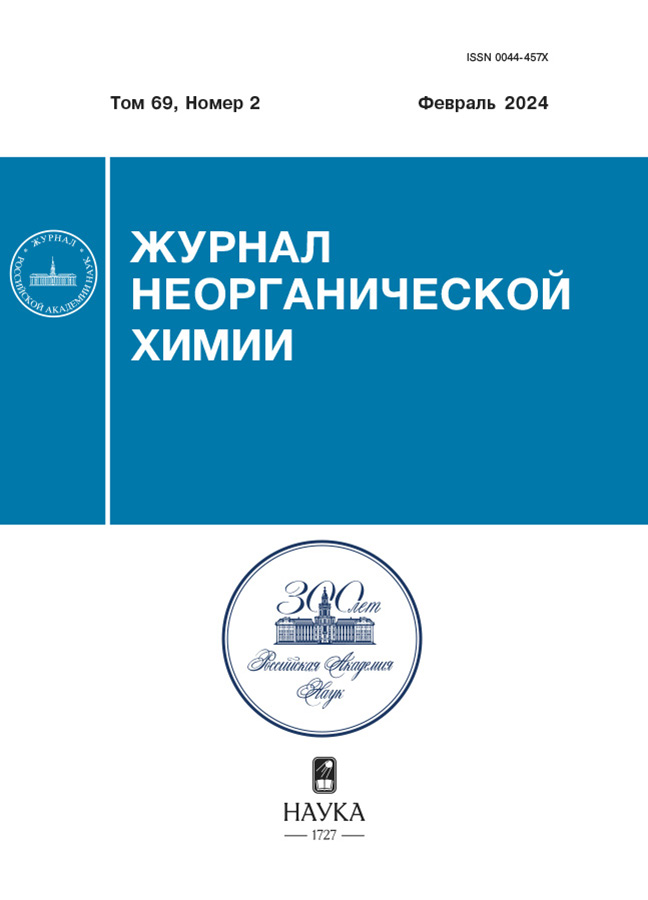Effect of superstoichiometric amounts of sodium and phosphorus on the phase composition and ionic conductivity of zirconium and sodium silicophosphates (NASICON)
- Authors: Grishchenko D.N.1, Podgorbunsky A.B.1, Medkov M.A.1
-
Affiliations:
- Institute of Chemistry, Far East Branch of the Russian Academy of Sciences
- Issue: Vol 69, No 2 (2024)
- Pages: 155-165
- Section: СИНТЕЗ И СВОЙСТВА НЕОРГАНИЧЕСКИХ СОЕДИНЕНИЙ
- URL: https://cardiosomatics.ru/0044-457X/article/view/665919
- DOI: https://doi.org/10.31857/S0044457X24020025
- EDN: https://elibrary.ru/ZIIITN
- ID: 665919
Cite item
Abstract
Using the method of pyrolysis of solutions in a melt, the phase formation of sodium and zirconium silicophosphates Na1+xZr2SixP3–xO12 was studied depending on the concentrations of sodium and phosphorus in the precursors. The influence of the content of these components, as well as firing conditions on the change in the ionic conductivity of NASICON was studied. Methods of X-ray phase analysis, scanning electron microscopy, full-profile Rietveld analysis, and electrochemical impedance spectroscopy were used. The specific values of grain conductivity (σb) and grain boundaries (σgb) of the samples were calculated. It was found that the reason for the change in ionic conductivity is a change in the composition of NASICON with increasing concentrations of sodium and phosphorus in the precursor. The main condition for high conductivity of the material is the formation of a crystalline phase corresponding to the composition Na3Zr2Si2РO12, as well as a minimum amount of impurities and glass phase. The conductivity of the NASICON sample (x = 2) under certain processing conditions is ~ 1 · 10-3 S/cm.
Full Text
About the authors
D. N. Grishchenko
Institute of Chemistry, Far East Branch of the Russian Academy of Sciences
Author for correspondence.
Email: grishchenko@ich.dvo.ru
Russian Federation, Vladivostok, 690022
A. B. Podgorbunsky
Institute of Chemistry, Far East Branch of the Russian Academy of Sciences
Email: grishchenko@ich.dvo.ru
Russian Federation, Vladivostok, 690022
M. A. Medkov
Institute of Chemistry, Far East Branch of the Russian Academy of Sciences
Email: grishchenko@ich.dvo.ru
Russian Federation, Vladivostok, 690022
References
- Goodenough J.B., Hong H.Y-P., Kafalas J.A. // Mater. Res. Bull. 1976. V. 11. № 2. P. 203. https://doi.org/10.1016/0025-5408(76)90077-5
- Hong H.Y-P. // Mater. Res. Bull. 1976. V. 11. № 2. P. 173. https://doi.org/10.1016/0025-5408(76)90073-8
- Li C., Li R., Liu K. et al. // Interdiscip. Mater. 2022. P. 1. https://doi.org/10.1002/idm2.12044
- Guin M., Tietz F. // J. Power Sources. 2015. V. 273. P. 1056. https://doi.org/10.1016/j.jpowsour.2014.09.137
- Lalere F., Leriche J.B., Courty M. et al. // J. Power Sources. 2014. V. 247. P. 975. https://doi.org/10.1016/j.jpowsour.2013.09.051
- Fergus J.-W. // Solid State Ionics. 2012. V. 227. P. 102. https://doi.org/10.1016/j.ssi.2012.09.019
- Narayanan S., Reid S., Butler S., Thangadurai V. // Solid State Ionics. 2019. V. 331. P. 22. https://doi.org/10.1016/j.ssi.2018.12.003
- Rao Y.B., Bharathi K.К., Patro L.N. // Solid State Ionics. 2021. V. 366–377. P. 115671. https://doi.org/10.1016/j.ssi.2021.115671
- Wang H., Zhao G., Wang S. et al. // Nanoscale. 2022. V. 14. № 3. P. 823. https://doi.org/10.1039/d1nr06959d
- Naqash S., Tietz F., Yazhenskikh E. et al. // Solid State Ionics. 2019. V. 336. P. 57. https://doi.org/10.1016/j.ssi.2019.03.017
- Грищенко Д.Н., Курявый В.Г., Подгорбунский А.Б., Медков М.А. // Журн. неорган. химии. 2023. Т. 68. № 1. С. 17. https://doi.org/10.31857/S0044457X22601043
- Fuentes R.O., Marques F.M.B., Franco J.I. // Bol. Soc. Esp. Cerám. Vidrio. 1999. V. 38. № 6. P. 631.
- Zhang S., Quan B., Zhiyong Z., Zhao B. // Materials Letters. 2004. V. 58. № 1. P. 226.
- Yang G., Zhai Y., Yao J. et al. // Chem. Commun. 2021. V. 57. P. 4023. https://doi.org/10.1039/d0cc07261c
- Brug G.J., van den Eeden A.L.G., Sluyters-Rehbach M., Sluyters J.H. // J. Electroanal. Chem. Interfacial Electrochem. 1984. V. 176. P. 275. https://doi.org/10.1016/S0022-0728(84)80324-1
- Bauerle J.E. // J. Phys. Chem. Solids. 1969. V. 30. P. 2657. https://doi.org/10.1016/0022-3697(69)90039-0
- Bauerle J.E., Hrizo J. // J. Phys. Chem. Solids. 1969. V. 30. P. 565. https://doi.org/10.1016/0022-3697(69)90011-0
- Kim S.K., Mao A., Sen S., Kim S. // Chem. Mater. 2014. V. 26. P. 5695. https://doi.org/10.1021/cm502542p
- Suzuki K., Noi K., Hayashi A., Tatsumisago M. // Scr. Mater. 2018. V. 145. P. 67. https://doi.org/10.1016/j.scriptamat.2017.10.010
- Ren K., Cao Y., Chen Y. et al. // Scripta Mater. 2020. V. 187. P. 384. https://doi.org/10.1016/j.scriptamat.2020.06.055
- Ngo Q.Q., Nguyen V.N., To V.N. et al. // Интеллектуальная электротехника. 2022. № 2. C. 16. https://doi.org/10.46960/2658-6754_2022_2_16
Supplementary files


















